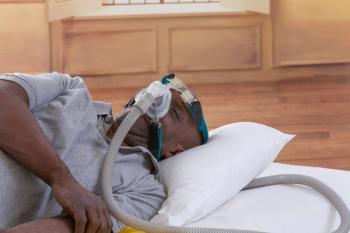
Cough Monitoring Device Could Help Refine Pulmonary Fibrosis Disease Management
Key Takeaways
- Chronic cough in pulmonary fibrosis affects quality of life and correlates with mortality, yet objective measurement remains challenging.
- A wearable device combined with machine learning may offer a solution for continuous cough monitoring in pulmonary fibrosis patients.
A wearable cough monitor generated clinically useful cough data, but patients only wore the device about half of the days of the study period.
The combination of a wearable cough-monitoring device and machine learning may one day allow for more precise monitoring of symptoms in patients with
The authors of the report cautioned, however, that it is not yet clear how closely cough data correlates with disease progression or activity. The report was
Chronic cough is a significant feature of interstitial lung disease, noted corresponding author Giovanni Ferrara, MD, PhD, of the University of Alberta, and colleagues.1 Cough can significantly affect quality of life in patients with lung disease, and
However, it is difficult to use cough as an objective indicator of disease severity because existing questionnaires are dependent upon patients’ recollections and may only capture patients’ experiences on a particular day.1 Other tools to monitor disease progression—such as spirometry and radiology—likewise only represent a single point in time, Ferrara and colleagues said.
“There is a clear need for technologies capable of assessing cough in these patients more frequently, and for extended periods,” they wrote.
One possible solution is to use a wearable device to monitor cough. Early research suggests such devices may be able to capture meaningful cough data, which could then be analyzed via machine learning to identify patterns associated with patient questionnaires. In particular, studies have
Ferrara and colleagues wanted to see how well the device would perform in a population of patients with pulmonary fibrosis.1 Their study had two key end points. The primary end point was to see whether patients would wear the device at least 70% of the days of the 6-month study protocol. The secondary end point was to see whether the data generated by the device could be meaningfully associated with 2 key lung disease questionnaires: the Leicester Cough Questionnaire (LCQ) and the King’s Brief Interstitial Lung Disease Questionnaire (K-BILD).
The investigators recruited 8 patients into the study. The patients ranged in age from 54 to 78 years old, and had varying diagnoses of pulmonary fibrosis, including IPF and PPF. Each of the enrollees completed baseline questionnaires, and all but one of the patients was taking disease-modifying therapy during the study period.
Patients’ device usage was lower than expected. Only one patient met the primary outcome threshold of wearing the device for at least 70% of the study’s days. That patient wore the device 85.6% of days. Another patient wore the device for 68.8% of the days. However, on average, participants only wore the device about half of the days of the study protocol. One patient swiftly left the study and never wore the device.
“The reasons for non-compliance were varied but included mild discomfort, inconvenience, and apathy towards adopting consistent use, as highlighted also by the fact that one patient left the study due to a moderate and reversible skin reaction and another one dropped out just after being enrolled,” Ferrara and colleagues wrote.
The authors said the low rates of device usage underscore the importance of wearable devices’ design and ergonomics.
Still, despite the low adherence, the investigators said the device still captured enough longitudinal data to correlate cough intensity with the K-BILD and LCQ questionnaires. Thus, they said, it may be that even partial usage of such devices can still yield clinically meaningful insights.
The authors cautioned, however, that given the study’s limited size, time frame, and the lack of spirometry and radiology end points, it is not yet possible to say whether the device can adequately track disease progression or activity. They added that cough intensity is not currently considered in clinical practice, and that cough is dynamic and patterns of cough highly variable.
Thus, while the authors said their study serves as a useful proof of concept for cough monitoring and machine learning in pulmonary fibrosis, further study will be needed to determine what role, if any, such technology should play in patient care.
References
1. Feist MD, Huang Y, Kalluri M, et al. Decoding objective cough features in progressive pulmonary fibrosis: A 6-month feasibility study. Am J Med. Published online August 5, 2025. doi:10.1016/j.amjmed.2025.07.027
2. Lee J, White E, Freiheit E, et al. Cough-specific quality of life predicts disease progression among patients with interstitial lung disease: data from the Pulmonary Fibrosis Foundation Patient Registry. Chest. 2022;162(3):603-613. doi:10.1016/j.chest.2022.03.025
3. Rhee H, Belyea MJ, Sterling M, Bocko MF. Evaluating the validity of an automated device for asthma monitoring for adolescents: correlational design. J Med Internet Res. 2015;17(10):e234. doi:10.2196/jmir.4975
Newsletter
Stay ahead of policy, cost, and value—subscribe to AJMC for expert insights at the intersection of clinical care and health economics.













































